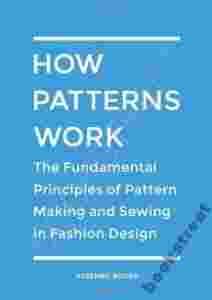The perfect introduction to the core principles
of garment construction, “How Patterns Work” simplifies
and explains the relationship between pattern making and
the body.
Instead of learning hundreds of separate
pattern making processes, “How Patterns Work” will break
the process into simple principles that can be applied
to any pattern change.
After reading this book, you
won’t just be able to follow pattern making instructions
- you will actually understand how and why pattern
making works and be able to adapt the principles for
yourself.
"How Patterns Work" has been designed
with:
- Over 70,000 words of text content.
- Over 250 diagrams in crisp black, white and grey.
- A clear table of contents for easy reference.
No previous knowledge of patterns or
sewing required. Chapters start from zero assumed
knowledge and build slowly in complexity with step by
step examples and clear diagrams.
The first section
of the book will answer questions such as:
- What are darts and how do they work with the
curves of the body?
- What is seam allowance and how much should you add
to your pattern?
- How are body measurements used to create accurate
patterns?
- What are blocks and how are they different to
patterns?
- What do the basic blocks look like?
This first section of the book will also
explain the overall anatomy of a pattern including the
definition and uses of notches, drill holes, grain lines
and body guidelines. All of the examples are shown in
relation to how the pattern will ultimately be sewn, so
that the principles become more relevant to real sewn
garments.
A large section of the book is devoted to
pattern examples that can be used as a reference library
to adapt and change to suit your own pattern making
needs.
The examples that are covered in this first
section include:
- Adding a seam line.
- Removing a seam line.
- Moving the position of a dart.
- Turning darts into seam lines.
- Turning seam lines into darts.
- Increase volume evenly.
- Decrease volume evenly.
- Increase volume around a point.
- Decrease volume around a point.
- Using darts to increase volume.
All of
the examples listed above are shown using both the cut
and spread, and the pivot flat pattern making methods,
and then also shown as a draped section of fabric on a
mannequin, allowing you to really see the pattern
changes as both a flat pattern, and in a more tangible
3D form.
Whether you are a novice fashion student, or
an experienced home sewer this is the perfect book to
simplify the terminology and principles behind complex
pattern making books and sewing courses.
Designed as
a companion guide to other pattern making texts, “How
Patterns Work” consolidates pattern making methods into
simple, memorable processes - making this book a perfect
refresher guide for even the most advanced pattern
maker.
Please note that this book does not include
paper patterns and does not cover specific pattern
drafting exercises. Instead, this book will provide you
with an overview to simplify the way you think about
pattern making, arming you with knowledge that can be
applied to any pattern change.

